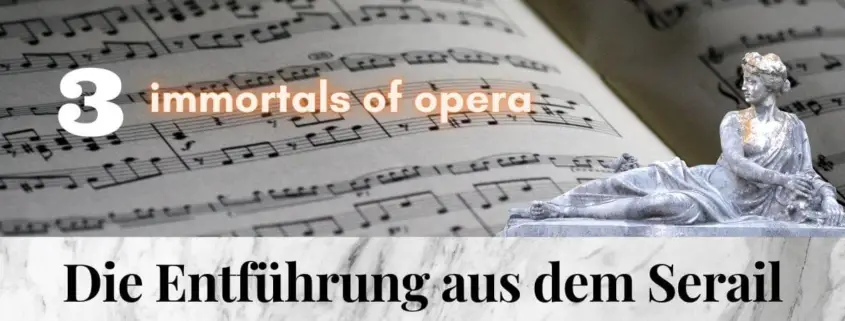Mozart was supposed to write a Singspiel for Emperor Joseph II. He fulfilled his wish and wrote the first really great work for this genre. At the same time, he broke the mold of the Singspiel and wrote one of his great masterpieces. The Abduction became one of his greatest successes in a sunny period of his life.
Mozart’s favorite aria – a lyrical heart-throb piece
Not for the last time, Mozart writes a beautiful piece about a beating heart (compare 10 years later the beautiful “batti o batti bel Masetto” from Don Giovanni), which he makes beat beautifully in the orchestra. It was one of Mozart’s favorite pieces. The dotted strings (composed in octaves) and the beautiful crescendi are very sensitively composed.
We hear Fritz Wunderlich in this aria. Wunderlich was considered the “ideal” Mozart tenor in the postwar years. Mozart’s tenor roles require an agile and lyrical voice, because they usually have to sing “only” emotions, since the action and its drama takes place in the recitatives.
O wie ängstlich, wie feurig klopft mein liebevolles Herz – Wunderlich
Constanze is ready for the torture
Mozart wrote a stunning piece for this drama of Konstanze’s soul. The so-called “Martern Aria” of Konstanze is one of the most difficult arias in opera literature. It demands strength for the long dramatic passages, great coloratura assurance and a considerable vocal range. It takes the voice all the way up to high D.
In addition, stamina is needed, because directly before this aria the singer already had to sing a great aria. If the preceding aria “Traurigkeit ward mir zum Lose” is in resigned, hopeless tone, Mozart shows Konstanze in the so-called “Martern-Arie” as a passionate woman ready for sacrifice.
This 10-minute piece is musically and dramatically immensely substantial and has also been described as a “concerto for coloratura soprano, solo instruments and orchestra.” The aria begins with an unusually long and overture-like introduction in which the solo instruments (oboe, flute, violin, cello) play colorful passages.
We hear this recording by Edda Moser. Moser was one of the great Mozart coloratura sopranos of the postwar period. She was a singer who gave herself uncompromisingly to her roles and never spared her voice. The power of her voice enabled her not only to sing coloratura roles, but also to shine in the dramatic field. Her recordings of Konstanze and the Queen of the Night glowed like a red flame. The latter even made it as a music title in the series of golden recordings that carried the Voyager spaceship into the vastness of space. The simultaneous agility and power of your voice is worth noting. For example, listen to the part where she sings the sustained C followed by a flawless trill (6:30).
Martern aller Arten (Marters of all kinds) – Moser.
Blonde and Pedrillo are ready for a risky escape from the seraglio
Osmin is triumphant – Mozart leads Osmin’s voice into the cellar
This aria is the most beautiful part of the part of Osmin. A gem for a comedic bass with great vocal range and an assured depth.
Kesting speaks highly of Kurt Moll’s Osmin: “Kurt Moll’s Osmin is one of the most haunting portraits and greatest vocal performances of the LP era.” One hears in this aria a great agility of voice (from 2:09) and the amazing vocal range that allows him to sing effortlessly the lowest note written in a known opera (the low D at 2:35)
O, wie will ich triumphieren – minor






Leave a Reply
Want to join the discussion?Feel free to contribute!